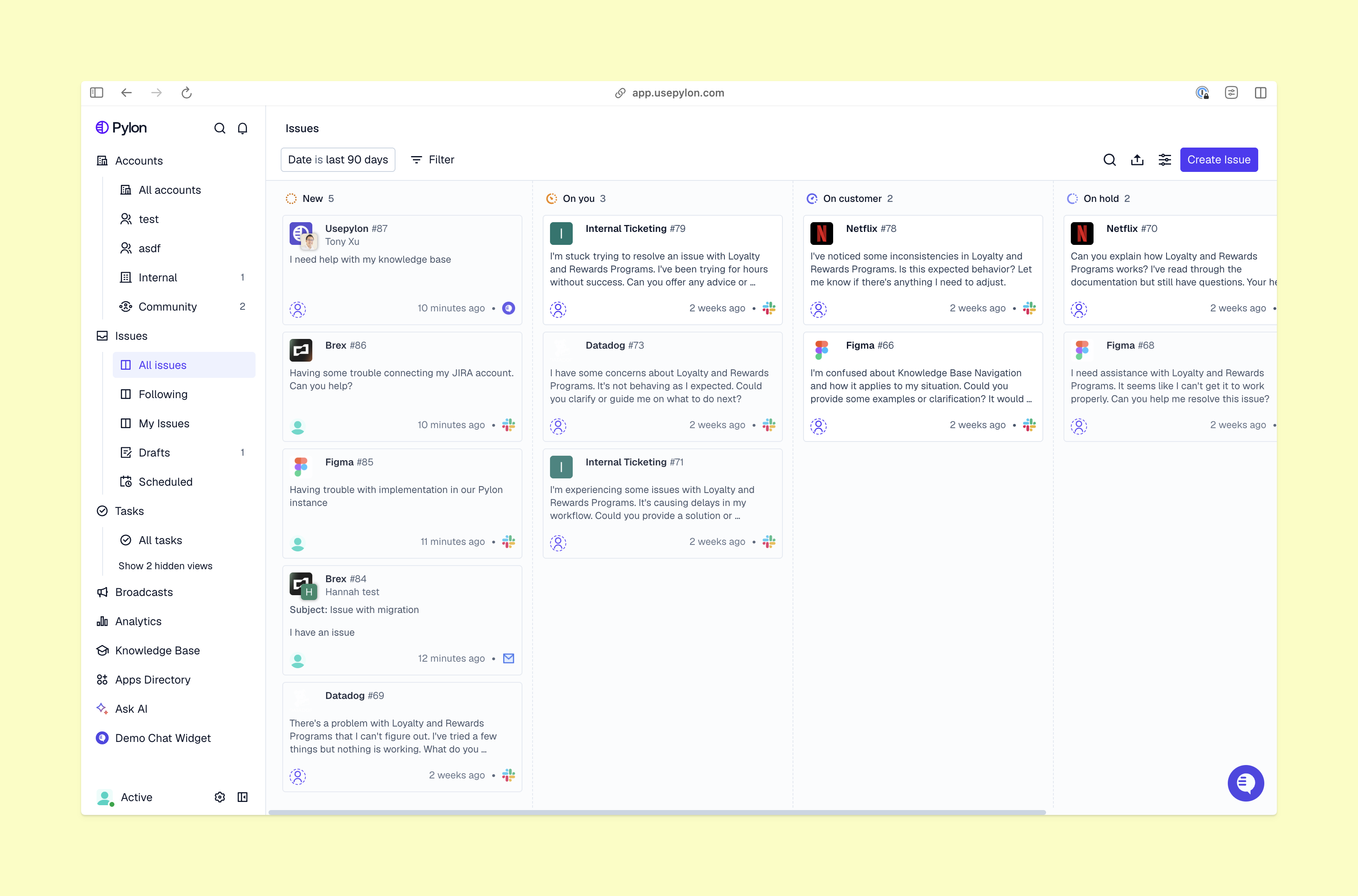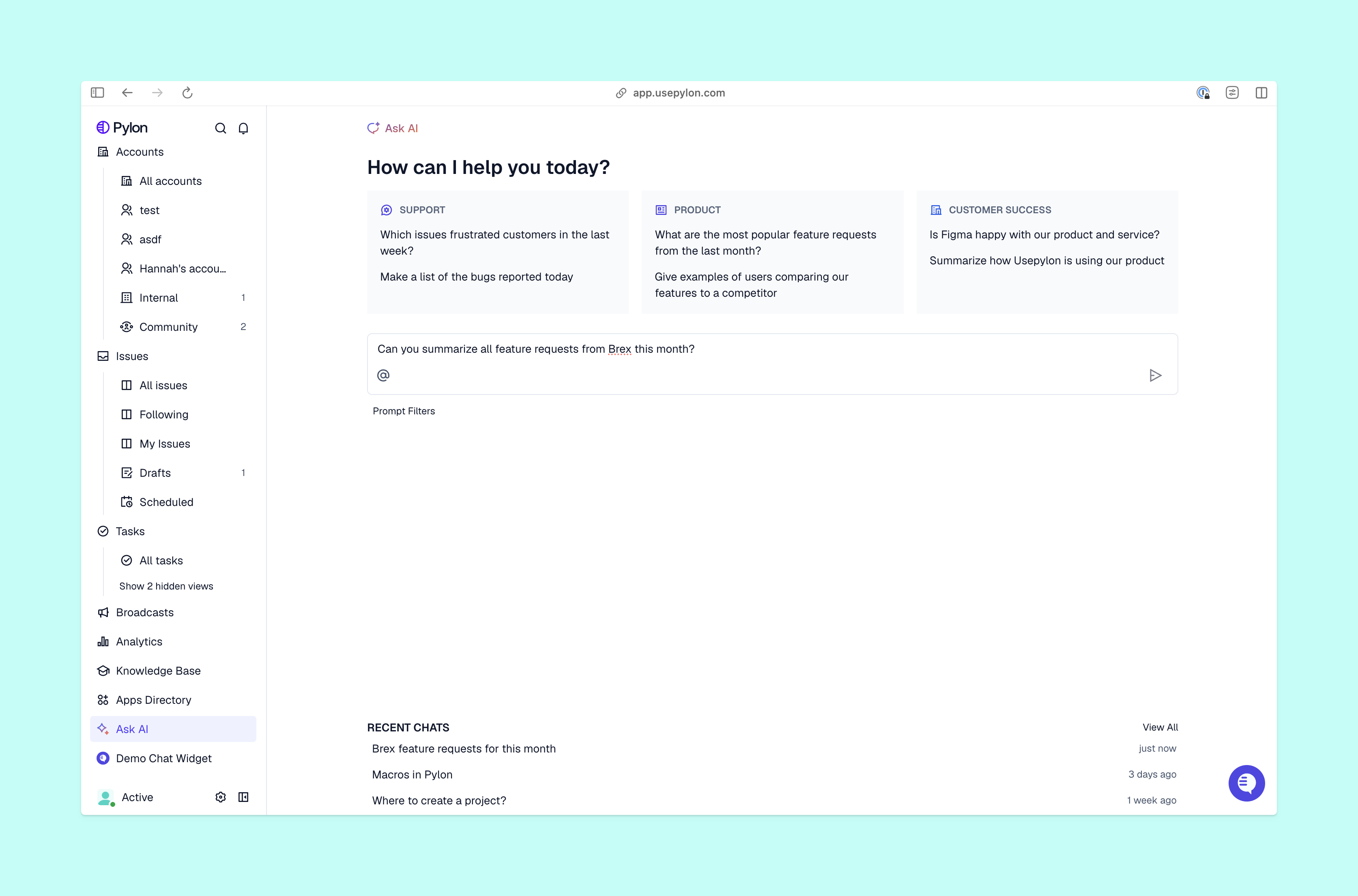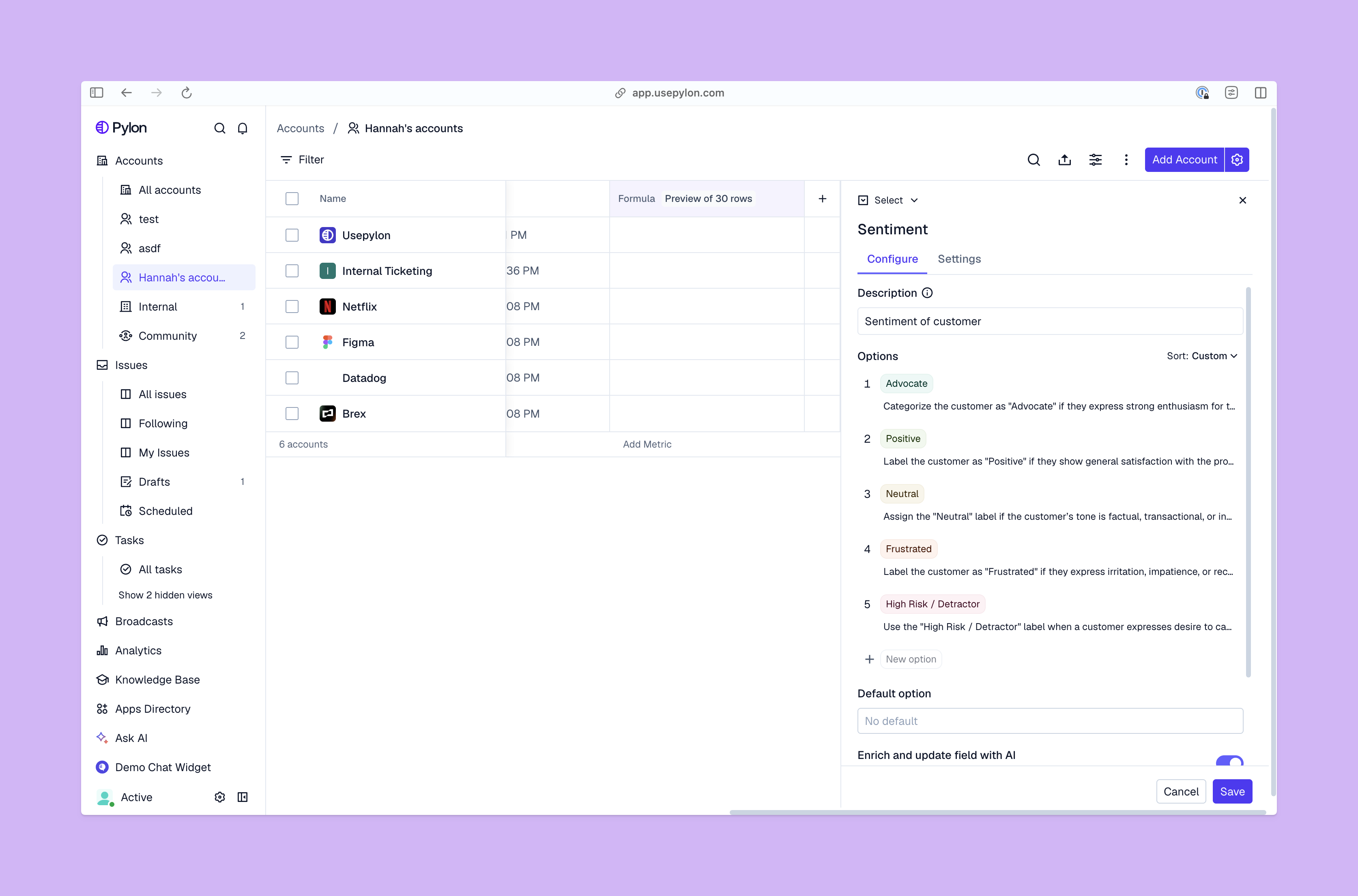Why B2B Companies Are Switching from Zendesk in 2025
Zendesk pioneered helpdesk software, but the platform hasn't kept pace with how modern B2B teams actually work. While Zendesk forces context-switches and charges premium prices for basic features, newer alternatives integrate natively with Slack, Discord, and Teams—delivering better experiences with transparent pricing.
Updated October 31, 2025 | 15 min read
TL;DR
B2B companies are increasingly moving away from Zendesk due to unpredictable costs, fragmented user experiences, and outdated interfaces. Modern alternatives like Pylon offer native integration with the tools your customers already use (Slack, Discord, Microsoft Teams), better AI-powered automation, transparent pricing, and faster implementation—helping startups and fast-growing B2B companies deliver exceptional support without the complexity.
Key takeaways:
- Modern platforms offer native integration with collaboration tools instead of forcing context switches
- AI-powered support is native, more accessible, and affordable in newer platforms
- Implementation time has dropped from weeks to days with modern solutions
- Features built for B2B, like Pylon’s Account Intelligence, are now standard in newer platforms
The Zendesk Reality Check: Why Companies Are Looking Elsewhere
For over a decade, Zendesk has been the go-to solution for customer support teams. But as the B2B support landscape evolves, more companies are discovering that what worked in 2015 doesn't meet their needs in 2025.
According to Freshworks, businesses often struggle with Zendesk's fragmented setup, where core modules like the admin center, analytics, and AI are spread across different consoles—frustrating administrators and delaying time-to-value.
The Four Main Pain Points Driving the Switch
1. Fragmented user experience
These days, many B2B teams’ customers want to communicate in platforms like Slack, Microsoft Teams, or Discord. Unlike Pylon’s native omnichannel support, Zendesk doesn’t have integrations that bi-directionally sync with these tools, so support teams are forced to context-switch constantly.
This fragmentation extends to the admin experience too. Setting up automation, managing AI tools, and accessing analytics in Zendesk all require navigating separate interfaces, which creates unnecessary friction for support leaders.
2. Slow and complex implementation
Traditional help desk software like Zendesk requires extensive setup time. What should take days often stretches into weeks or months as teams wrestle with configuration, integrations, and training.
Fast-growing B2B companies need support systems that can be deployed quickly. Modern platforms can be operational in days, not months—that’s critical when you're racing to support a growing customer base.
3. Unpredictable costs
Zendesk's pricing structure starts at $55/seat/month for the Support Suite and goes up to $169/seat/month for the enterprise plan. According to Quidget's analysis, you can then choose add-ons, with AI capabilities priced separately at $1.50/resolution for AI Agents and $50/seat for Copilot—but there’s a mandate to purchase licenses for all seats.
For a team of 15 that needs AI support, annual costs can exceed $15,000 before accounting for data storage fees, advanced security, and other "essentials" that most modern platforms include by default.
4. AI that feels like an afterthought
Zendesk's AI capabilities come from multiple acquisitions (Ultimate.ai, Cleverly, Klaus) that feel loosely stitched together rather than natively integrated. This results in a fragmented experience where admins have to access AI features through independent modules, complicating setup and training.
Modern alternatives like Pylon have built AI into their core product from day one, making it easier to deploy and more effective at resolving issues.
What Modern B2B Support Platforms Do Differently
The next generation of customer support software is purpose-built for how teams actually work in 2025. Here's what sets them apart:
Native Integration with Collaboration Tools

Instead of forcing customers to email or visit a portal, modern platforms meet them where they already are. Tools like Pylon integrate directly with:
- Slack: Provide support directly in Slack channels where your customers already communicate with your team
- Discord: Deliver customer support on Discord for developer-focused products and gaming companies
- Microsoft Teams: Offer Microsoft Teams helpdesk capabilities for enterprise customers
This eliminates context-switching and keeps conversations flowing naturally. Check out our practical guide to omnichannel support to learn more.
Built-In AI from Day One

Modern platforms don't treat AI as an expensive add-on. AI-powered customer support is core to the product, with features like:
- Smart ticket routing: Automatically assign issues to the right team member based on expertise and workload
- AI-powered responses: Generate suggested replies using your knowledge base and past conversations
- Intelligent triage: Prioritize urgent issues and flag VIP customers automatically
- Autonomous resolution: Let AI Agents handle common and repetitive questions
Pylon's AI Assistants learn from your team's responses and improve over time, while AI Knowledge Management automatically keeps your documentation up-to-date.
Account Intelligence for B2B

B2C support focuses on individual tickets. For B2B, teams need account-level context to provide personalized support. Modern platforms like Pylon ingest all your conversational data to unify:
- Complete customer journey across all touchpoints
- Usage data and analytics
- Revenue data and expansion opportunities
- Automated account health scoring
Pylon's Account Intelligence helps your team flag churn risks, identify upsell opportunities, and track account health, so you can turn customer insights into proactive customer success.
Transparent Pricing
Modern platforms have learned from Zendesk's pricing mistakes. Instead of surprise charges for storage, security, or essential features, they offer:
- Clear pricing with no hidden fees
- Flexible scaling that doesn't penalize growth
- Inclusive migration assistance
Rapid Implementation
Get up and running in days, not months:
- Out-of-the-box integrations with popular tools
- Intuitive interfaces that require minimal training
- Templates for common workflows and automation
- Dedicated onboarding support
How Startups and Fast-Growing B2B Companies Should Evaluate Alternatives
To choose the right customer service software, you need to understand your team’s specific needs and growth trajectory.
For Early-Stage Startups (Pre-Series A)
At this stage, you need something that works immediately even if you don’t have dedicated support staff.
Key requirements:
- Quick setup
- Native integrations with Slack or Discord, or wherever your customers already are
- Basic automation to handle common questions
- Pricing that scales with your growth
- Minimal training required
What to avoid:
- Complex platforms with long implementation cycles
- Systems that require dedicated administrators
Consider platforms that let you use Slack as a ticketing system or provide Slack customer support tools to streamline your workflow.
For Series A/B Companies (10-50 Employees)
You're scaling fast and need systems that grow with you without requiring constant reconfiguration.
Key requirements:
- Omnichannel support across multiple channels
- Advanced automation and routing capabilities
- AI-powered features to increase efficiency
- Detailed analytics and reporting
- Account-level context for B2B interactions
- Integration with your CRM and data warehouse
What to avoid:
- Systems that require major reconfiguration as you scale
- Solutions without B2B-specific capabilities
Learn more about B2B omnichannel support best practices at this stage.
For Growth-Stage Companies (50+ Employees)
At this point, support is a strategic function. You need sophisticated tools and deep integrations.
Key requirements:
- Advanced AI capabilities for automation and insights
- Comprehensive knowledge base software for self-service
- Deep integrations with business intelligence tools
- Advanced reporting and analytics
- Team management and workflow optimization
- Enterprise-grade security and compliance
The Top Zendesk Alternatives for B2B Companies in 2025
Based on extensive research from Zendesk alternative comparisons, here are the leading options:
1. Pylon

Best for: B2B companies that want robust integrations with communication platforms, native AI capabilities, and tools for proactive customer support and success
Key strengths:
- Native integrations for Slack, Discord, and Microsoft Teams
- Built-in AI Agents and AI Assistants for automation
- Account Intelligence for proactive B2B support and customer success
- Transparent pricing
- Implementation and data migration support
Pricing: Check usepylon.com/pricing
Learn more: View Pylon's docs and knowledge base
2. Freshdesk
Best for: Small businesses that need basic helpdesk functionality
Key strengths:
- Free plan for up to 10 seats
- Lower cost than Zendesk ($15/seat vs $55/seat)
- Comprehensive ticketing features
- AI tools at more affordable pricing
Limitations:
- Traditional helpdesk interface that requires context-switches
- Less focus on modern collaboration tool integration
- More complex as you scale
3. Salesforce Service Cloud
Best for: Traditional enterprises that already use Salesforce CRM
Key strengths:
- Deep CRM integration across sales and support
- Customization capabilities
- Einstein AI platform
Limitations:
- Expensive (starting at $165/seat/month for meaningful features)
- Complex setup that requires dedicated IT resources
- Steep learning curve
- Long implementation timeline
4. Gorgias
Best for: Online retailers, especially on Shopify
Key strengths:
- Shopify integration with order management
- Ticket-based pricing model
- E-commerce specific features
Limitations:
- Limited to e-commerce use cases
- Fewer integrations than competitors (around 100 vs 1,500+)
- Basic automation capabilities
5. Help Scout
Best for: Small teams focused on email support
Key strengths:
- Simple, intuitive interface
- Unlimited seats on contact-based pricing
- Quick implementation
Limitations:
- Limited to email and basic chat
- Minimal workflow automation
- Not suitable for complex B2B needs
Making the Switch: A Practical Migration Guide
Moving from Zendesk to a modern alternative doesn't have to be disruptive. Here's how successful companies approach the transition:
Phase 1: Assessment (Week 1)
Document your current state:
- Total Zendesk costs including all add-ons and hidden fees
- Key workflows and automations you've built
- Integrations with other tools
- Pain points your team experiences daily
- Features you actually use vs. pay for
Define success metrics:
- Response time targets
- Resolution rate goals
- Customer satisfaction benchmarks
- Team productivity measures
- Cost reduction objectives
Phase 2: Evaluation (Weeks 2-3)
Test during real conditions:
- Run trials during your busiest support periods
- Have your entire team test, not just managers
- Migrate a subset of real data to test workflows
- Verify all critical integrations work smoothly
Key questions to answer:
- How long does implementation actually take?
- What's the true total cost including any hidden fees?
- How much training will your team need?
- What migration support is provided?
- What does the customer experience look like?
Visit the Pylon docs to see how quickly you can get started.
Phase 3: Migration (Weeks 4-6)
Prepare your data:
- Export conversation history and customer data from Zendesk
- Clean up outdated tickets and duplicate customers
- Document custom fields and their purposes
- Map your current workflows to the new platform
Run parallel systems:
- Keep Zendesk running while you set up the new platform
- Route select customers or channels to the new system first
- Monitor performance closely
- Gather team feedback daily
Train your team:
- Start with power users who can become internal champions
- Create custom documentation for your specific workflows
- Schedule hands-on training sessions
- Set up a support channel for questions
Phase 4: Full Rollout (Week 7+)
Go live strategically:
- Switch during a typically slower support period
- Have all hands on deck for the first few days
- Monitor key metrics closely
- Gather customer feedback proactively
Optimize continuously:
- Review analytics weekly to identify bottlenecks
- Refine automations based on real usage
- Expand AI capabilities as your team gets comfortable
- Document best practices for new team members
Hidden Zendesk Costs to Watch For
With Zendesk, you need to be aware of the following hidden costs:
- Per-resolution fees for AI usage
- Storage overage charges
- Premium support packages
- Integration marketplace apps
- Custom reporting tools
- Advanced security features
On the other hand, most modern platforms have:
- Transparent scaling costs
- Included migration assistance
- Included onboarding and training
Frequently Asked Questions (FAQ)
1. How long does it take to migrate from Zendesk to a modern alternative?
Most modern platforms like Pylon can be fully implemented in 1-3 days with proper preparation. The migration process typically involves:
- Data export from Zendesk (1-2 hours)
- Setting up your new workspace (2-4 hours)
- Configuring integrations and workflows (4-8 hours)
- Team training (2-4 hours)
- Running parallel systems for testing (3-7 days recommended)
Total timeline: 1-2 weeks for a complete, confident migration.
2. Will I lose my historical ticket data when switching?
No. Reputable platforms provide migration tools to preserve your conversation history, customer data, and knowledge base articles. When migrating to Pylon, all your historical data is imported and remains searchable. Visit our support documentation for detailed migration guides.
3. How much can I actually save by switching from Zendesk?
Based on analysis from multiple comparison sources, companies typically save 50-85% on their support software costs by switching to modern alternatives. For a 15-person team, this translates to $15,000-35,000 in annual savings. Calculate your specific savings by adding up all Zendesk fees including:
- Base subscription
- AI add-ons
- Additional channels
- Storage fees
- Premium support
- Implementation costs
4. What about AI capabilities? Are alternatives as good as Zendesk?
Modern alternatives often have superior AI capabilities because they're built into the product from day one rather than acquired and loosely integrated. For example:
- Pylon's AI Agents learn from your actual support conversations and documentation
- Smart routing improves over time based on resolution outcomes
- Context-aware responses leverage full account history and product usage data
Learn more about AI-powered customer support best practices.
5. Can modern platforms handle enterprise-level security requirements?
Yes. Modern B2B platforms are built with enterprise security as a baseline, not an add-on:
- SOC 2 Type II compliance
- GDPR and CCPA compliance
- SSO and SAML authentication
- Role-based access controls
- Audit logging
- Data encryption at rest and in transit
- Regular security audits
Check Pylon's security page for details.
6. How do I convince my team to switch from a platform they're familiar with?
Focus on pain points rather than features:
- Calculate actual costs including all Zendesk add-ons and hidden fees
- Measure time wasted on context-switching and navigating multiple interfaces
- Run a pilot with a small team or channel to demonstrate improvements
- Highlight quick wins like faster response times and reduced manual work
- Emphasize training support provided during migration
Most teams who trial modern alternatives don't want to go back.
7. What happens to my Zendesk integrations?
Modern platforms offer pre-built integrations with popular tools and APIs for custom connections. When evaluating alternatives:
- List all your current integrations
- Verify availability in the new platform's marketplace
- Test critical integrations during your trial period
- Work with the vendor to build custom integrations if needed
Pylon's integrations page shows all available connections.
8. Is it better to use Slack/Discord directly or use a dedicated support platform?
Using collaboration tools directly for support creates several problems:
- No ticket tracking or SLA management
- Conversations get lost in busy channels
- No reporting or analytics on support performance
- Can't route to the right person automatically
- Knowledge gets siloed in individual threads
Modern platforms like Pylon give you the best of both worlds—support happens in Slack/Discord where customers are comfortable, but you get all the structure, automation, and analytics of a proper support platform. Read our guide on how to use Slack for customer support effectively.
9. How do modern platforms handle omnichannel support?
True omnichannel support means:
- Unified customer view across all channels (Slack, Discord, Teams, email, chat)
- Conversation continuity when customers switch channels
- Consistent experience regardless of how customers reach out
- Centralized management so your team isn’t juggling multiple tools
See our practical guide to omnichannel support for implementation tips.
10. What's the biggest mistake companies make when evaluating alternatives?
The most common mistake is testing platforms in ideal conditions rather than real-world scenarios:
- Don't just test with administrators—have frontline team members use it during actual support hours
- Don't test with sample data—migrate a subset of real customers and tickets
- Don't evaluate during slow periods—test during your busiest support times
- Don't skip integration testing—verify all your critical tools work together
- Don't rush the decision—give your team at least 2 weeks with the platform
Take the Next Step: Evaluate Modern Alternatives
The customer support landscape has evolved dramatically, and platforms built for 2025 offer compelling advantages over legacy solutions like Zendesk:
✅ 50-85% cost savings with transparent pricing
✅ Native integration with tools your team already uses
✅ Faster implementation in days, not months
✅ Better user experience for both teams and customers
If you're experiencing any of these Zendesk pain points:
- Unpredictable, escalating costs
- Fragmented interfaces requiring constant context-switching
- Complex setup and administration
- AI that feels bolted-on rather than integrated
- Lack of B2B-specific features like unified account context
...it might be time to explore modern alternatives.
More resources to help you decide:
- Complete Zendesk Alternatives Guide
- Zendesk vs Pylon Comparison
- Pylon Documentation
- Customer Case Studies
Ready to Switch from Zendesk?
The future of B2B customer support isn't about forcing customers into your workflow—it's about meeting them where they already are. With modern platforms, you can deliver exceptional support without the complexity and costs of legacy systems.
Pylon is the modern B2B support platform that offers true omnichannel support across Slack, Teams, email, chat, ticket forms, and more. Our AI Agents & Assistants automate busywork and reduce response times. Plus, with Account Intelligence that unifies scattered customer signals to calculate health scores and identify churn risk, we're built for customer success at scale.




